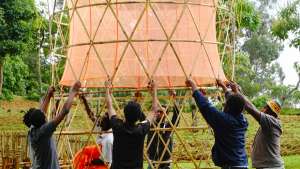From the Series
In March this year, a tide of frustration swept across the nation. It brought to light a burning anger in South African youth, many of whom believe the continued idolisation of apartheid colonial figures, like Cecil John Rhodes and Paul Kruger, is symbolic of the lack of transformation in South African institutions. Feeling this frustration, artist Haroon Gunn-Salie thought an act of vandalism would be enough to voice his opinion.
“I had been planning an act of vandalism on a series of monuments around the country, with purple dye,” he says smirking at the camera. The purple dye would symbolise the dye used by the apartheid regime to mark protesters. But the concept had already taken root in the hearts of a student movement called Rhodes Must Fall.
All over the country, monuments were vandalised with faeces and paint, and protests were staged, all calling for the removal of colonial figures from universities and other institutions.
“I sat there thinking, ‘that’s so serendipitous’,” he says. Gunn-Salie realised his responsibility was then to take these debates to a different level - an educational level. His exhibition, History After Apartheid, held at the Goodman Gallery in Johannesburg, engages the issues by documenting the social intervention that has already occurred.
He began by obtaining permission from the government to cast the hands of colonial figures directly from their statues. Gunn-Salie says, a number of people were offended and felt threatened by his casting of the monuments, as there was a great potential to cast these figures in a negative light.
“When we were casting Paul Kruger in Krugersdorp, we had the AWB [Afrikaner Resistance Movement] come to us fully armed, telling us: 'Get your hands off our hero',” says Gunn-Salie.
He explains that while the work is a comment on the reaction of dissatisfied young people, it is also a provocation of reactions on site.
The disembodied, red arms of the contentious figures, removed from their hierarchical position in society, calls on viewers to address the perpetual feeling of inferiority felt by Africans when confronted by figures of colonial heritage.
“The struggle for social economic justice is more important than ever,” says the artist. “Our people live in a more impoverished state than they ever have. There is still a lot of work to be done, especially for young people.”








